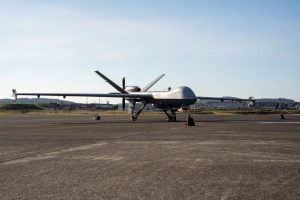The Japanese Defense Ministry has announced that all eight U.S. MQ-9 Reaper unmanned aerial vehicles (UAVs), currently deployed at the Japan Maritime Self-Defense Force (JMSDF)’s Kanoya Air Base in Kagoshima Prefecture on Kyushu, will be relocated to U.S. Forces’ Kadena Air Base on Okinawa, the largest U.S. Air. Force base in Asia, in November.
The announcement came after Japan’s Defense Minister Kihara Minoru and his U.S. counterpart, Lloyd Austin, reaffirmed the importance of MQ-9 drones in joint intelligence, surveillance, and reconnaissance (ISR) efforts at their meeting in Washington, D.C., on October 4.
U.S. Forces in Japan deployed the drones in the newly formed 319th Expeditionary Reconnaissance Squadron at Kanoya Air Base on Kyushu, or the southernmost of Japan’s main islands, for a planned one-year period starting from November 21, 2022. Since then, the Reapers have been conducting warning and surveillance missions, mainly over the East China Sea, with an eye on China’s increasing maritime activities near Japan.
“As the security environment becomes increasingly severe, we will further strengthen the deterrence and response capabilities of the Japan-U.S. Alliance, including intelligence gathering capabilities,” Kihara said at a press conference on October 10 when asked about the purpose of relocating the MQ-9s to Kadena.
In particular, the defense minister cited as the number one reason the stern security environment in Japan’s southwestern Nansei island chain, which spans about 1,200 km from Kagoshima to Okinawa, stretching southwest toward Taiwan. The chain includes the disputed Senkaku/Diaoyu Islands, which are controlled by Japan but also claimed by China and Taiwan.
“With the activities of countries surrounding Japan becoming more active and the need for information gathering in the sea and airspace around Japan’s southwest region increasing, the deployment of the U.S. Air Force MQ-9 to Kadena Air Base will be able to provide easier access to the region and increase the time to carry out ISR activities in a closer distance [than Kanoya Air Base],” Kihara stressed.
An MQ-9 is about 11 meters long and 20 meters wide. It is equipped with an electro-optical/infrared sensor turret for ISR duties. It has a maximum take-off weight of 4,760 kg; a cruise speed of 180 knots (333 km/h); a range of 5,293 miles (8,519 km); and an endurance of 32 hours, according to the Defense Ministry.
Japan’s Defense Ministry explained the relocation plan on October 6 to the Okinawa prefectural government and the relevant municipalities in the prefecture: Okinawa City, Chatan Town, and Kadena Town. It said the U.S. military will begin relocating eight MQ6 aircraft and about 100 personnel to Kadena Air Base in mid-October, and will finish deploying them to the base by November.
In response, the mayors of the three local governments asked questions about safety and noise of the MQ6 aircraft. Chatan Town Mayor Toguchi Masashi flatly objected to the relocation plan, saying, “We cannot accept an increase in the burden on the [Kadena] base,” according to local media reports in Okinawa.
Japan’s southernmost island prefecture of Okinawa already bears the heavy burden of housing around half of the roughly 55,000 U.S. military personnel in the country. Local residents have voiced their concerns and protests over the noise generated by U.S. military planes inside and outside the air base. In a major lawsuit, some 35,500 residents near the base are demanding that the Japanese government pay damages over the noise pollution and suspend night and early morning flights at the Kadena base.
Despite the 1972 transfer of Okinawa from U.S. to Japanese control, U.S. military bases still occupy about 15 percent of the main Okinawa island. About 70 percent of all U.S. bases and facilities in Japan are still concentrated in Okinawa Prefecture, which accounts for only about 0.6 percent of Japan’s total land area.
Currently, Japan and the United States are increasingly bolstering an integrated deterrence strategy in the Asia-Pacific, with plans to deploy hundreds of U.S.-made Tomahawk cruise missiles as early as fiscal year 2025 as well. The U.S. military is also planning to establish in Japan a command post for its Space Force in the near future, with an aim to strengthen cooperation between Japan and the United States in response to China’s expanding military use of space and North Korea’s development of nuclear weapons and missiles.
































